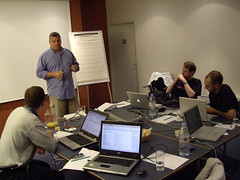Ok. I put my hands on Mandriva 2008.
I must say honestly, I never liked Mandriva (Mandrake) too much. In the times when I was working for MaxWeber, I tried to use it as my main distro for some time and I felt like in a candy shop, with all those plastic colors, plus the overall experience was pretty “old-fashion-linux-like” in terms of feeling that I’m using a combination of pieces glued together. It’s my old and well known accusion against KDE. (Gnome was a bit better, especially in Ubuntu edition)
I hope that the past did not influence my review, thus I decided it’s better to inform readers about it, to stay fair.
I focused during this test course on the things that are specific to Mandriva distribution plus the overall experience during 10-20 minutes test. It’s not sufficient to put any general statements about the quality and (same as with OpenSUSE 10.3 UX review) I’d like people to give it a try before judging. I did not install Mandriva 2008, and this may influence the experience I have had, altough most of the things I focused on are unrelated to what could have change in the installed system. (that statement bases on my knowledge about Linux and installation processes).
The first thing you see after booting from the CD is a nice, blueish theme. It’s still a bit too candy like, but I feel ok with that, and I’m sure many people will really find it attractive.
A little glitch with grub is that you see a (themed) menu but with only one option to choose and 10 delay before auto starting it. Most people won’t notice, and you can’t say it’s a bug, but what for? I can guess that it’s made to allow some people in corner cases modify the launch options, but once more the sin of Linux Distributions is presented. Majority experiences options made for minority.
Boot screen is just like a modern boot theme in Linux distros. I find it less attractive than suse’s one, but that’s probably because I spent so much time with designers and they raped my aesthetics, so in result I love when things are very small. suse’s progress bar is smaller. 😉
The first thing that I found different to most live cd’s is that you have to make some choices before seeing the deskop. You’re choosing languages, time zone, time format, 3d special effects (metisse, compiz fusion or nothing).
I can understand the reason for which they did it. Especially the 3d part makes you aware of what the desktop will be like. There is a clear description of each choice, so even a novice user will understand the consequences of his choice. User who’s already aware of what he’s doing (experienced linux user testing mandriva) will like this idea. I like it. It makes it possible for me to choose in 3 steps how I want the desktop to looks like.
